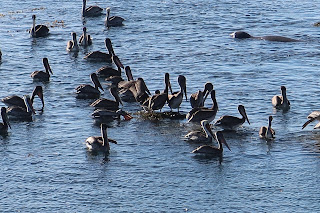http://www.sanluisobispo.com/news/local/community/cambrian/cambrian-opinion/article196370769.html
You hear them as soon as you get out of the car. It’s pup time at Piedras Blancas. More than 5,000 pups will be born in the rookery, which extends from beyond the light station in the north to about two miles south of the viewpoint.
Most pups are born at night, but you might be fortunate enough to be watching when one is born on the beach.
Each pup is accompanied by a mother, and mature males hover, awaiting the opportunity to mate. It’s one of the busiest months on the beach, and the most active.
Females are still arriving to give birth. Look for seals that are urgently tossing sand on their backs. It doesn’t have much to do with the process, but seals seem to do it when they are stressed.
Once born, the pups need to start nursing. The first pup was born on the south end of the beach Dec. 16, so that pup will be the first one weaned. Look for rotund, fat pups. Some will learn to steal milk from other mothers, ballooning up to even more than the usual 300 pounds. Those 500-pounders are superweaners.
Although mothers and pups bond to each other at birth, barking and sniffing at each other, it’s far from a perfect system. Eighty percent of pups nurse on at least one mother other than their own. Not every pup survives, and those bereaved mothers may adopt one or more strays. Some mothers are particular and chase pups other than their own away, but most are tolerant. Elephant seal mothers have never been observed to give birth to more than one pup at a time.
Nursing more than one pup puts the nursing couple in jeopardy. Mothers don’t eat while they are nursing. They produce the milk from their blubber, losing two pounds for every pound the pup gains. Stray pups are nursing from a limited source.
It appears to even out. Around 95 percent of pups at Piedras Blancas survive to be weaned. Younger mothers may gain experience by nursing more than one pup. Pups of experienced mothers are more likely to survive.
As pups are weaned, mothers come into estrus, heat, like dogs. They mate before they return to the ocean, thin and in need of food. They’ll spend three moths feeding before they return to the beach with some of their blubber reserves restored.
Estrus and mating spark battles between males. Most dominance interactions are simple: a challenge and a retreat. But with breeding rights at stake, males are willing to fight. They bump chests and rip at each other’s chest shield, the crinkled skin around the neck, with their teeth. Battles can be bloody. Dominant males take no notice of pups or mothers as they chase each other across the beach. Pups can be separated from their mothers, a serious problem and the single most common cause of pup death. Pups can even be killed as males land on top of them in their determination to be the most dominant, or to mate with the mother.
Watch as two bulls challenge each other, and their conflict ripples through the rest of the seals. With new females arriving, pups born, pups being weaned, mothers mating and departing, the scene is constantly changing.






















